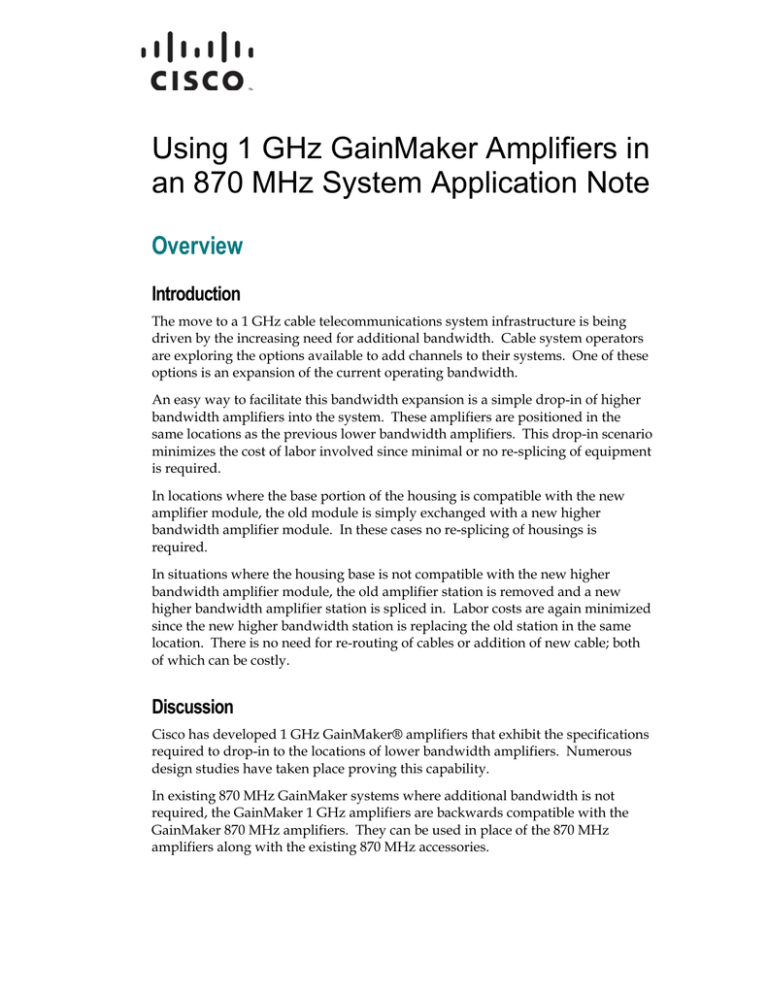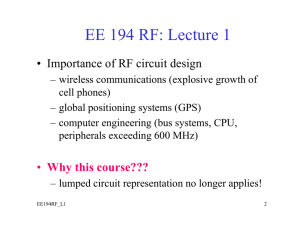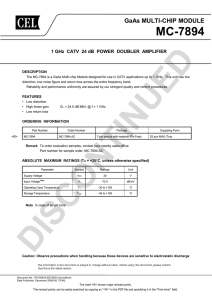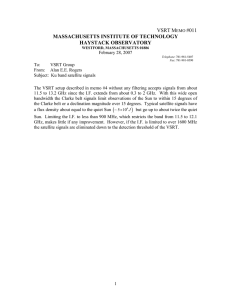
Using 1 GHz GainMaker Amplifiers in
an 870 MHz System Application Note
Overview
Introduction
The move to a 1 GHz cable telecommunications system infrastructure is being
driven by the increasing need for additional bandwidth. Cable system operators
are exploring the options available to add channels to their systems. One of these
options is an expansion of the current operating bandwidth.
An easy way to facilitate this bandwidth expansion is a simple drop-in of higher
bandwidth amplifiers into the system. These amplifiers are positioned in the
same locations as the previous lower bandwidth amplifiers. This drop-in scenario
minimizes the cost of labor involved since minimal or no re-splicing of equipment
is required.
In locations where the base portion of the housing is compatible with the new
amplifier module, the old module is simply exchanged with a new higher
bandwidth amplifier module. In these cases no re-splicing of housings is
required.
In situations where the housing base is not compatible with the new higher
bandwidth amplifier module, the old amplifier station is removed and a new
higher bandwidth amplifier station is spliced in. Labor costs are again minimized
since the new higher bandwidth station is replacing the old station in the same
location. There is no need for re-routing of cables or addition of new cable; both
of which can be costly.
Discussion
Cisco has developed 1 GHz GainMaker® amplifiers that exhibit the specifications
required to drop-in to the locations of lower bandwidth amplifiers. Numerous
design studies have taken place proving this capability.
In existing 870 MHz GainMaker systems where additional bandwidth is not
required, the GainMaker 1 GHz amplifiers are backwards compatible with the
GainMaker 870 MHz amplifiers. They can be used in place of the 870 MHz
amplifiers along with the existing 870 MHz accessories.
Overview
Moving to higher bandwidth amplifiers in an existing system raises an interesting
question among some operators. “How will this 1 GHz amplifier work in my 870
MHz system?” This paper addresses this concern and shows that a seamless
integration can easily take place. Issues such as cable loss, amplifier gains, gain
tilt, equalizing, and padding are addressed.
2
4011634 Rev C
EQ, tilt, and gain
EQ, tilt, and gain
Equalizer value versus tilt
Equalizers are designated by stating the loss of the coaxial cable for which they must
compensate.1 The value of the equalizer is based on the amount of cable that
produces a loss at the upper most frequency that is equal to the given value. An
equalizer is designed to compensate for that amount of cable and it will have
characteristics inverse to that of the cable. It will exhibit its highest loss at the lowest
frequency and its lowest loss at the highest frequency.
The tilt produced by an equalizer is simply the difference in loss between the lowest
and highest frequency (or the two frequencies of interest). It is important to note
that the equalizer tilt and equalizer value are two distinctly different terms and
should not be interchanged. An EQ value X dB will produce a tilt of Y dB.
Gain
Amplifier gains are developed to compensate for the loss created by coaxial cable
and passive components used in the system. In architectures where the desired
effect is to increase the bandwidth of the system without moving amplifier locations,
the gain must be such that it will match the loss of the existing spacing at the new
higher frequency. The gain of the new higher bandwidth amplifier must be higher
than the lower bandwidth amplifier it replaces.
Higher gain may also translate to longer spacing between amplifiers. The higher
gain can be fully utilized in new or rebuild designs. In an existing system, where
amplifier locations are already set, any additional or excess gain is attenuated away.
If this additional gain is not too excessive, it can be attenuated at the amplifier inputs
without causing any significant impact to the system carrier-to-noise.
Gain in an amplifier also exhibits a slope (or tilt). This gain tilt or internal tilt is the
difference in gain between the highest and lowest frequency in the downstream
passband of the amplifier. Plotting this tilt on a graph provides the ability to
determine the gain at other frequencies.
4011634 Rev C
3
Gain and cable loss
Gain and cable loss
870 MHz Gain in a 1 GHz Amplifier
Figures 1 and 2 demonstrate the internal tilts of the GainMaker 1 GHz amplifiers.
Figure 1 shows the plot of a 1 GHz station with 15.5 dB internal tilt. It can be seen
that the gain at 870 MHz will be 1.3 dB less than the 1 GHz gain. This is typical of
the High Gain Dual (HGD), High Gain Balanced Triple (HGBT), and Unbalanced
Triple (UBT) amplifiers.
Figure 1. 1 GHz station with 15.5 dB internal tilt
As seen in Figure 2, a 1 GHz station with 9.5 dB of internal tilt will have 0.8 dB less
gain at 870 MHz. This is seen in the Low Gain Dual (LGD) and Line Extender (LE)
amplifiers.
4
4011634 Rev C
Gain and cable loss
Figure 2. 1 GHz station with 9.5 dB of internal tilt
In a 1 GHz GainMaker amplifier, the gain at 870 MHz will be somewhat higher than
the 870 MHz version of the same model amplifier. This is brought about by the use
of equalizer circuits to create the internal tilt and the increases in gain and tilt
designed into the amplifier.
Table 1 shows the gains of the various amplifiers in both their 1 GHz and 870 MHz
versions. The column to the right shows the difference in 870 MHz gain between the
1 GHz and 870 MHz amplifiers.
Table 1. Gains of the various 1 GHz and 870 MHz amplifiers
4011634 Rev C
5
Gain and cable loss
Cable loss
Signal attenuation through coaxial cable increases at higher frequencies. This
increase is not linear. It is a function of the square root of the frequency ratio. That
is why, when plotted on a linear graph, cable loss will exhibit a bow shape. Cable
equalizers, when plotted on the same linear graph, will exhibit a bow shape inverse
to that of the cable.
As discussed in the previous section and shown in Figures 1 and 2, this contributes
to the additional gain at 870 MHz in a 1 GHz amplifier.
6
4011634 Rev C
Pad and equalizer adjustments
Pad and equalizer adjustments
Pad and equalizer adjustments when using 870 MHz equalizers
Replacing an 870 MHz amplifier with a similar 1 GHz version will require some
minor rebalancing of the amp. In a system where 870 MHz equalizers will continue
to be used, a higher value input pad and a lower value input EQ are needed to set
the station back to its original 870 MHz output levels. This is due to the slight
increase in gain and internal tilt.
In order to demonstrate the effects on the input pad and equalizer, the example in
Figure 3 is provided. In the drawings, the levels and loss above the coax line and the
gain preceding the slash (/) are representative of 870 MHz. The levels and losses
below the coax line and the gain after the slash (/) are representative of 50 MHz.
Figure 3. Pad and equalizer adjustments when using 870 MHz equalizers
870 MHz Amplifiers
HGD
HGD
10 dBmV
50 dBmV
-30 dB at 870 MHz
50 dBmV
20 dBmV
Gain =
40/27.5 dB
Gain =
40/27.5 dB
37.5 dBmV
-6.9 dB at 50 MHz
37.5 dBmV
30.6 dBmV
10 dBmV
-10.6 dB tilt arriving at amp
0 dB input tilt required
Select 13.5 dB 870 MHz EQ (10.6 dB tilt)
Select 10 dB pad
1 GHz Amplifiers
HGD
HGD
8.3 dBmV
Gain =
41.7/27.5
dB
50 dBmV
-30 dB at 870 MHz
37.5 dBmV
-6.9 dB at 50 MHz
20 dBmV
Gain =
41.7/27.5
dB
30.6 dBmV
50 dBmV
37.5 dBmV
10 dBmV
TP044
-10.6 dB tilt arriving at amp
-1.7 dB input tilt required
Select 12.0 dB 870 MHz EQ (9.4 dB tilt)
Select 11.5 dB pad
Generally, a couple rules of thumb can be applied to the input pad and equalizer
selection when using the 870 MHz equalizers. These changes are based on
comparison to the existing 870 MHz input pad and equalizer.
For the input equalizer - decrease the equalizer one value (-1.5 dB). Amplifiers
spaced within 2 dB of maximum gain may require a two value decrease (-3.0 dB).
4011634 Rev C
7
Pad and equalizer adjustments
For the input pad - increase the pad 1.5 dB for the amplifiers with a 1.7 dB gain
delta and increase the pad 1.0 dB for the amplifiers with a 1.2 dB gain delta. See
Table 1.
Pad and equalizer adjustments when using 1 GHz equalizers
In a system where the 1 GHz equalizers will be used, the changes to the pad and EQ
values will vary based on the amount of cable being equalized for between any two
amplifiers. The key here is to select the 1 GHz EQ based on the tilt created between
50 and 870 MHz. Since the absolute loss changes at 870 MHz based on the EQ value,
the pad selection is affected. Remember, there is 1.2 to 1.7 dB of excess gain that can
be taken up by the additional EQ loss at 870 MHz. After this, the input pad value
will need to decrease proportionally to the increase in the 870 MHz loss of the
equalizer.
In order to demonstrate the effects on the input pad and equalizer, the following
example is provided. In the drawings, the levels and loss above the coax line and
the gain preceding the slash (/) are representative of 870 MHz. The levels and loss
below the coax line and the gain after the slash (/) are representative of 50 MHz.
Figure 4. Pad and equalizer adjustments when using 1 GHz equalizers
870 MHz Amplifiers
HGD
HGD
10 dBmV
50 dBmV
-30 dB at 870 MHz
20 dBmV
37.5 dBmV
-6.9 dB at 50 MHz
30.6 dBmV
Gain =
40/27.5 dB
50 dBmV
Gain =
40/27.5 dB
37.5 dBmV
10 dBmV
-10.6 dB tilt arriving at amp
0 dB input tilt required
Select 13.5 dB 870 MHz EQ (10.6 dB tilt)
Select 10 dB pad
1 GHz Amplifiers
HGD
HGD
8.3 dBmV
Gain =
41.7/27.5
dB
50 dBmV
-30 dB at 870 MHz
37.5 dBmV
-6.9 dB at 50 MHz
20 dBmV
Gain =
41.7/27.5
dB
30.6 dBmV
50 dBmV
37.5 dBmV
10 dBmV
TP045
8
-10.6 dB tilt arriving at amp
-1.7 dB input tilt required
Select 12.0 dB 1 GHz EQ (8.7 dB tilt)
Input padding required = 11.7 dB
Additional EQ loss = 0.9 dB at 870 MHz
Subtract additional EQ loss
Select 11 dB pad
4011634 Rev C
Pad and equalizer adjustments
Here again, a couple rules of thumb can be applied to the pad and equalizer
selection when using the 1 GHz equalizers. These changes are based on comparison
to the existing 870 MHz input pad and equalizer.
For the input equalizer - decrease the equalizer one value (-1.5 dB). In some
cases, the equalizer value may not need to change for amplifiers spaced within 2
dB of maximum gain.
For the input pad - increase the pad 1.0 dB for the amplifiers with a 1.7 dB gain
delta and increase the pad 0.5 dB for the amplifiers with a 1.2 dB gain delta. See
Table 1.
The 1 GHz equalizer has additional loss at 870 MHz. As seen in the previous
section, when 870 MHz equalizers were used, the input pad was used to offset
the increased gain. Now the additional equalizer loss offsets some of that
increased gain. Amplifiers spaced within 2 dB of maximum gain are unlikely to
require a change to the input pad.
4011634 Rev C
9
Cascade performance
Cascade performance
An example of noise and distortion calculations for a cascade is a clear way to show
the impacts of the slight additional gain at 870 MHz. Assuming a cascade of a node
plus 6 amplifiers with a preceding fiber link, the carrier to noise and distortion ratios
can be calculated and compared. In this example, the node and amplifiers are
operating at 50 dBmV output at 870 MHz with a 12.5 dB output tilt. The node is a
GainMaker High Gain Balanced Triple followed by three High Gain Duals and three
Line Extenders.
The 1 GHz node and amplifiers are modeled with the additional gain at 870 MHz
that would be expected (see Table 1). The performance numbers in Table 2 show the
end-of-line (EOL) results for each of two scenarios. The first is the original 870 MHz
cascade. The second is the same cascade after replacing the node and each amplifier
with a 1 GHz version of each unit. The calculations for the 1 GHz model are based
on operation to 870 MHz for an even comparison.
Table 2. End-of-line results
As can be seen in the table above, there is a negligible degradation to the carrier to
noise performance. When we examine the performance of the RF section (Node +
Amps), there is a 0.3 to 0.4 dB change to CTN. Once the fiber link performance is
added in, this change is diluted to 0.1 dB in each case since the fiber link is the
dominant CTN contributor. Other nodes, cascades, levels, etc. can be considered in a
comparison model like this. It is not expected to see anything greater than 0.5 dB
degradation to the EOL CTN.
A benefit to the cascade performance can be seen in the distortion performance. The
improvement in the station distortion performance of the 1 GHz products is
reflected in the EOL performance.
10
4011634 Rev C
Summary
Summary
Migrating to a 1 GHz node and amplifier platform should be viewed as an easy and
beneficial move. The benefits in performance and bandwidth enhancement
capability far outweigh any negatives. There is no additional cost to deploy the
higher bandwidth equipment when compared to deploying the same model lower
bandwidth equipment.
Optimizing the 1 GHz equipment for the existing 870 MHz bandwidth is a
straightforward process. There are minimal changes required to the input pad and
equalizer regardless of whether the 870 MHz or 1 GHz equalizers are used to
maintain the existing 870 MHz system. From an operational standpoint, it is easier
to make those changes at the amplifier input rather than trying to re-configure the
inter-stage losses to change the gains and tilts. As shown in the performance
calculations, there isn't any significant degradation to the system performance.
On the other hand, setting the stage for a 1 GHz bandwidth expansion does require
some pre-engineering and analysis of the existing system and levels. The only
decision will be whether to limit the new equipment to the existing lower operating
bandwidth or set it up initially for the capability to operate at its full bandwidth.
4011634 Rev C
11
Loss tables
Loss tables
Table 3. Forward Cable Equalizers - 870 MHz - Loss Table
EQ
Value
Part
Number
Typical Insertion Loss (dB) at Various Frequencies (MHz)
52
70
86
550
600
650
750
870
0
589260
-
-
-
-
-
-
-
-
1.5
589261
2.2
2.1
2.1
1.3
1.3
1.2
1.1
1.0
3.0
589262
3.3
3.2
3.2
1.7
1.6
1.5
1.2
1.0
4.5
589263
4.5
4.4
4.2
2.0
1.9
1.7
1.4
1.0
6.0
589264
5.7
5.5
5.3
2.4
2.1
1.9
1.5
1.0
7.5
589265
6.9
6.6
6.4
2.7
2.4
2.1
1.6
1.0
9.0
589266
8.0
7.7
7.5
3.1
2.7
2.4
1.7
1.0
10.5
589267
9.2
8.8
8.5
3.4
3.0
2.6
1.9
1.0
12.0
589268
10.4
10.0
9.6
3.7
3.3
2.8
2.0
1.0
13.5
589269
11.6
11.1
10.7
4.1
3.6
3.1
2.1
1.0
15.0
589270
12.8
12.2
11.8
4.4
3.9
3.3
2.2
1.0
16.5
589271
13.9
13.3
12.8
4.8
4.1
3.5
2.3
1.0
18.0
589272
15.1
14.4
13.9
5.1
4.4
3.7
2.5
1.0
19.5
589273
16.3
15.5
15.0
5.5
4.7
4.0
2.6
1.0
21.0
589274
17.4
16.7
16.1
5.8
5.0
4.2
2.7
1.0
22.5
589275
18.6
17.8
17.2
6.1
5.3
4.4
2.8
1.0
24.0
589276
19.8
18.9
18.2
6.5
5.6
4.7
2.9
1.0
25.5
589277
21.0
20.0
19.3
6.8
5.8
4.9
3.1
1.0
27.0
589278
22.1
21.1
20.4
7.2
6.1
5.1
3.2
1.0
(dB)
12
4011634 Rev C
Loss tables
Table 4. Forward Cable Equalizers - 1 GHz - Loss Table
EQ
Value
Part
Number
Typical Insertion Loss (dB) at Various Frequencies (MHz)
52
70
86
550
600
650
750
870
1002
0
4007228
-
-
-
-
-
-
-
-
-
1.5
4007229
2.2
2.2
2.1
1.4
1.4
1.3
1.2
1.1
1.0
3.0
4007230
3.4
3.3
3.2
1.9
1.8
1.7
1.5
1.2
1.0
4.5
4007231
4.6
4.4
4.3
2.3
2.1
2.0
1.7
1.4
1.0
6.0
4007232
5.8
5.6
5.4
2.7
2.5
2.3
1.9
1.5
1.0
7.5
4007233
7.0
6.7
6.5
3.2
2.9
2.6
2.1
1.6
1.0
9.0
4007234
8.2
7.9
7.7
3.6
3.3
3.0
2.4
1.7
1.0
10.5
4007235
9.4
9.0
8.8
4.0
3.7
3.3
2.6
1.8
1.0
12.0
4007236
10.6
10.2
9.9
4.5
4.0
3.6
2.8
1.9
1.0
13.5
4007237
11.8
11.3
11.0
4.9
4.4
3.9
3.1
2.0
1.0
15.0
4007238
13.0
12.5
12.1
5.3
4.8
4.3
3.3
2.2
1.0
16.5
4007239
14.2
13.6
13.2
5.8
5.2
4.6
3.5
2.3
1.0
18.0
4007240
15.4
14.8
14.3
6.2
5.5
4.9
3.7
2.4
1.0
19.5
4007241
16.6
15.9
15.4
6.6
5.9
5.3
4.0
2.5
1.0
21.0
4007242
17.8
17.1
16.5
7.1
6.3
5.6
4.2
2.6
1.0
22.5
4007243
19.5
18.7
18.1
8.0
7.2
6.4
4.9
3.2
1.5
24.0
4007244
20.7
19.9
19.2
8.4
7.6
6.7
5.2
3.4
1.5
25.5
4007245
21.9
21.0
20.3
8.8
7.9
7.1
5.4
3.5
1.5
27.0
4007246
23.1
22.2
21.5
9.3
8.4
7.4
5.6
3.6
1.5
28.5
4007247
24.3
23.3
22.6
9.7
8.7
7.7
5.8
3.7
1.5
30.0
4007248
25.5
24.5
23.7
10.1
9.1
8.0
6.1
3.8
1.5
(dB)
4011634 Rev C
13
For Information
For Information
Support Telephone Numbers
If you have technical questions, call Cisco Services for assistance. Follow the menu
options to speak with a service engineer.
14
4011634 Rev C
Cisco Systems, Inc.
5030 Sugarloaf Parkway, Box 465447
Lawrenceville, GA 30042
678 277-1120
800 722-2009
www.cisco.com
Cisco and the Cisco logo are trademarks or registered trademarks of Cisco and/or its affiliates
in the U.S. and other countries. To view a list of Cisco trademarks, go to this URL:
www.cisco.com/go/trademarks .
Third party trademarks mentioned are the property of their respective owners.
The use of the word partner does not imply a partnership relationship between Cisco and any
other company. (1110R)
Product and service availability are subject to change without notice.
© 2008, 2012 Cisco and/or its affiliates. All rights reserved.
August 2012 Printed in USA
Part Number
4011634 Rev C




